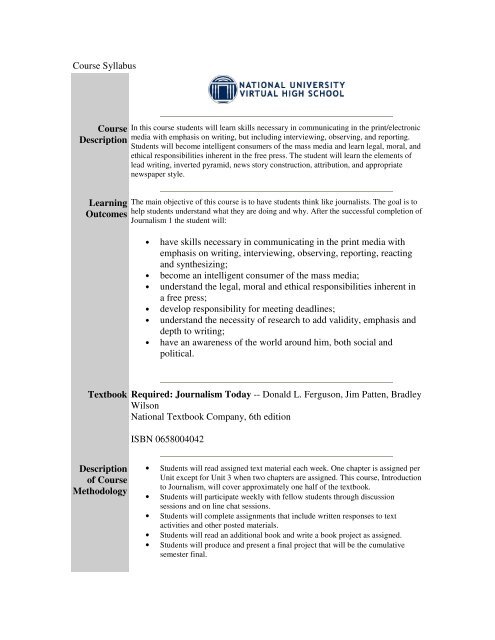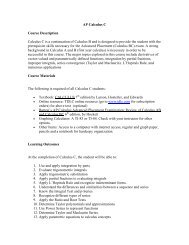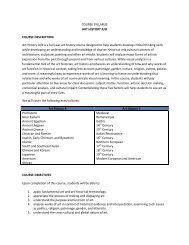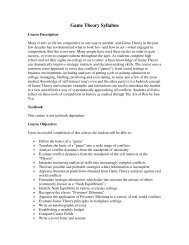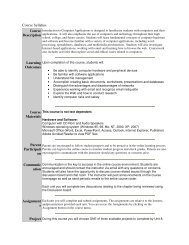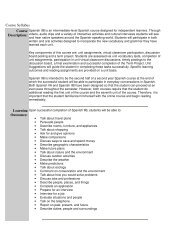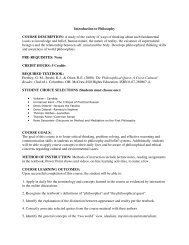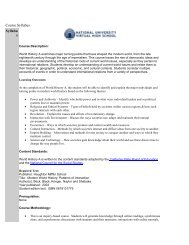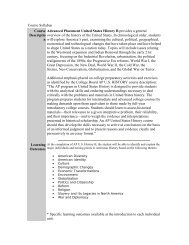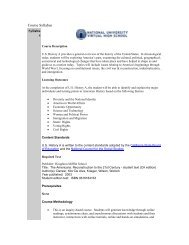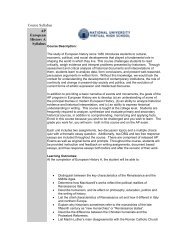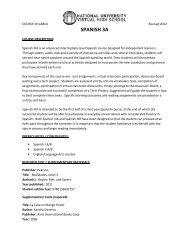Introduction to Journalism Syllabus
Introduction to Journalism Syllabus
Introduction to Journalism Syllabus
Create successful ePaper yourself
Turn your PDF publications into a flip-book with our unique Google optimized e-Paper software.
Course <strong>Syllabus</strong><br />
Course<br />
Description<br />
In this course students will learn skills necessary in communicating in the print/electronic<br />
media with emphasis on writing, but including interviewing, observing, and reporting.<br />
Students will become intelligent consumers of the mass media and learn legal, moral, and<br />
ethical responsibilities inherent in the free press. The student will learn the elements of<br />
lead writing, inverted pyramid, news s<strong>to</strong>ry construction, attribution, and appropriate<br />
newspaper style.<br />
Learning<br />
Outcomes<br />
The main objective of this course is <strong>to</strong> have students think like journalists. The goal is <strong>to</strong><br />
help students understand what they are doing and why. After the successful completion of<br />
<strong>Journalism</strong> 1 the student will:<br />
• have skills necessary in communicating in the print media with<br />
emphasis on writing, interviewing, observing, reporting, reacting<br />
and synthesizing;<br />
• become an intelligent consumer of the mass media;<br />
• understand the legal, moral and ethical responsibilities inherent in<br />
a free press;<br />
• develop responsibility for meeting deadlines;<br />
• understand the necessity of research <strong>to</strong> add validity, emphasis and<br />
depth <strong>to</strong> writing;<br />
• have an awareness of the world around him, both social and<br />
political.<br />
Textbook Required: <strong>Journalism</strong> Today -- Donald L. Ferguson, Jim Patten, Bradley<br />
Wilson<br />
National Textbook Company, 6th edition<br />
ISBN 0658004042<br />
Description<br />
of Course<br />
Methodology<br />
• Students will read assigned text material each week. One chapter is assigned per<br />
Unit except for Unit 3 when two chapters are assigned. This course, <strong>Introduction</strong><br />
<strong>to</strong> <strong>Journalism</strong>, will cover approximately one half of the textbook.<br />
• Students will participate weekly with fellow students through discussion<br />
sessions and on line chat sessions.<br />
• Students will complete assignments that include written responses <strong>to</strong> text<br />
activities and other posted materials.<br />
• Students will read an additional book and write a book project as assigned.<br />
• Students will produce and present a final project that will be the cumulative<br />
semester final.
Assessment<br />
One Time Assignments<br />
Assignment<br />
Points<br />
Pretest 10<br />
Book Project 25<br />
Final Project 45<br />
Overall Assignments<br />
Assignment Points per Unit Total (8 Units)<br />
Participation 5 40<br />
Weekly Assignments 10 80<br />
200 points possible: for a passing grade, you must earn 120 points or higher<br />
Grading Scale<br />
Letter Grade<br />
Points<br />
A 200 – 180<br />
B 179 – 160<br />
C 159 – 140<br />
D 139 – 120<br />
F 119 – 0<br />
Course<br />
Procedures,<br />
Required<br />
Activities,<br />
and<br />
Assignments<br />
You should plan <strong>to</strong> participate in this course by logging on a minimum of 3 times each<br />
week of the eight week period. The asynchronous (not in real time) nature of the course<br />
activities and assignments will permit you <strong>to</strong> take part at times most convenient <strong>to</strong> you.<br />
The most important thing <strong>to</strong> remember is that you are responsible for reading the material<br />
and completing the assignments for each week. Late work will not be accepted so it is<br />
imperative for you <strong>to</strong> schedule your time wisely <strong>to</strong> complete all necessary assignments in<br />
a timely manner.<br />
All assignments are due by Friday of each week. You will submit homework assignments<br />
<strong>to</strong> the Blackboard posting as indicated. Post your response <strong>to</strong> the Discussion Board by<br />
Wednesday of each week. Then go back and respond <strong>to</strong> one or more of your classmate’s<br />
responses by Friday of that week.<br />
Active participation for this course means posting your response <strong>to</strong> the discussion<br />
question(s) asked, reading other posted responses, and responding back <strong>to</strong> your<br />
classmates work in a way that furthers the discussion and/or provides additional resources<br />
relating directly <strong>to</strong> the <strong>to</strong>pic under discussion. Discussion responses should be submitted<br />
<strong>to</strong> the appropriate weekly forum in the Discussion Forum of the Discussion Board of the<br />
classroom. Please remember <strong>to</strong> be courteous and appropriate in your replies <strong>to</strong> you fellow<br />
classmates.<br />
NOTE: Please be mindful of online netiquette. Posts should be in short digestible<br />
paragraphs. Quality of the response is what is important.<br />
Please avoid drive-by postings. Drive-by postings are those made by students once a<br />
week. The student logs in, reads the discussion questions/responses, and the responds <strong>to</strong><br />
them all, all at once. The student is not seen again for a week. Drive-by posters are not<br />
contribu<strong>to</strong>rs <strong>to</strong> the flow of the discussion and have not vested in becoming members of<br />
the class community. Points will be deducted for drive-by posters.
Rubric for<br />
Participation<br />
Grade<br />
5 points:<br />
• Student has responded <strong>to</strong> at least the two required questions and <strong>to</strong> one<br />
classmate<br />
• Comments/questions were responsive <strong>to</strong> the discussion question<br />
• Comments or questions significantly enhanced the equality of discussion (i.e.<br />
illustrated a point with examples, suggested new perspectives on an issue, asked<br />
questions that helped further discussion, etc.)<br />
• Provided constructive feedback <strong>to</strong> classmates<br />
• Comments/questions provided evident that the student has read and considered a<br />
substantial number of classmates’ postings before responding<br />
3-4 points:<br />
• Student has posted a minimum of two times <strong>to</strong> the discussion board<br />
• Comments/questions were reasonably responsive <strong>to</strong> the discussion<br />
• Comments/questions enhanced the quality of discussion (i.e. illustrated a point<br />
with an example, suggested new perspectives on an issue, asked questions that<br />
helped further discussion, etc.)<br />
• Provided constructive feedback <strong>to</strong> classmates<br />
• Comments/questions provided evidence that the student has read and considered<br />
at least some classmates’ postings before responding<br />
1-2 points:<br />
• Student has posted a minimum of one time <strong>to</strong> the discussion board<br />
• Comments/questions were reasonably responsive <strong>to</strong> the discussion board<br />
• Comments/questions provided evidence that the student has read and considered<br />
at least some classmates’ postings before responding


